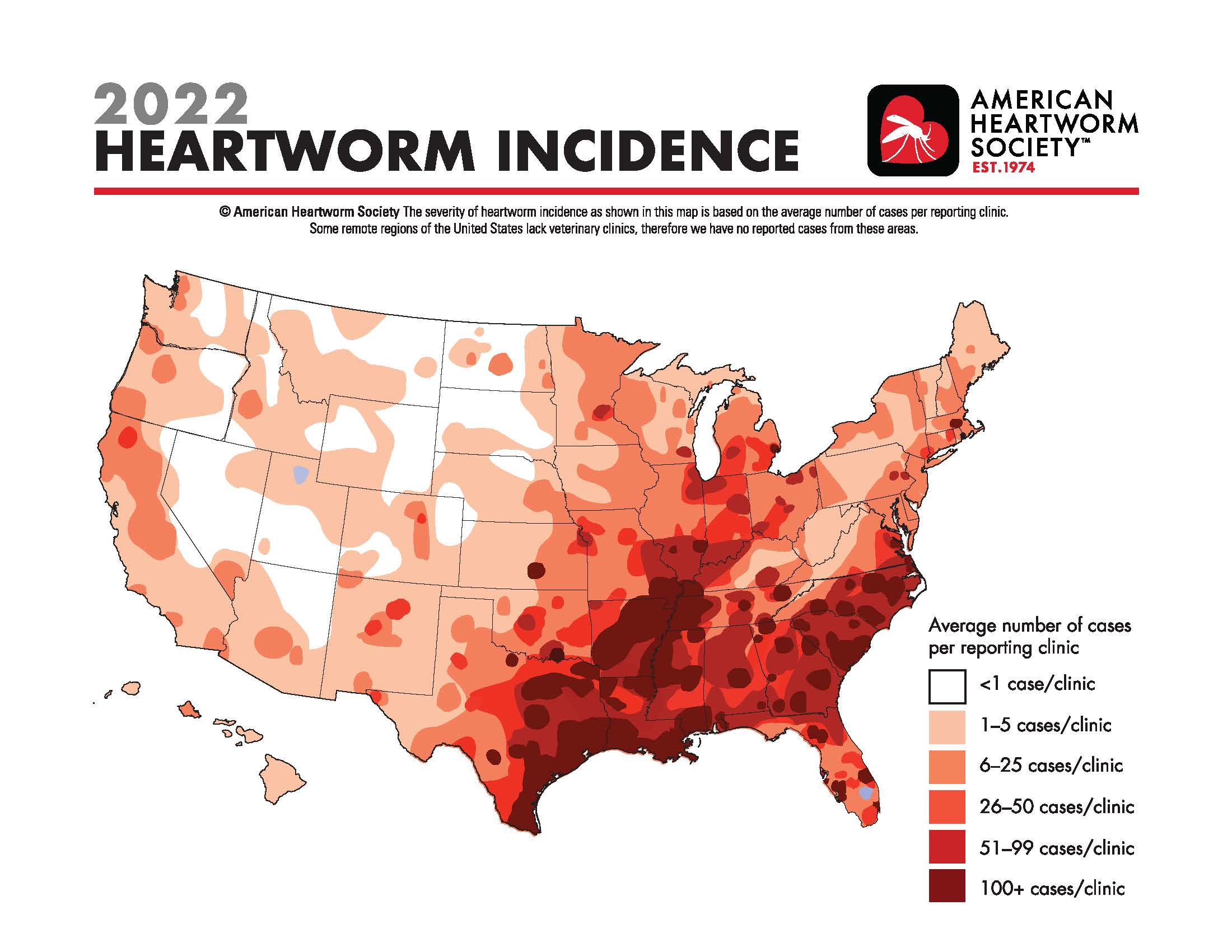Understanding Heartworm Disease: Symptoms, Prevention, and Treatment
Understanding Heartworm Disease: Symptoms, Prevention, and Treatment
Heartworm disease is a serious and sometimes deadly ailment that can affect dogs everywhere. While every state has the risk of heartworms for dogs, along the Atlantic and Gulf coats you’ll find a higher incidence of heartworm disease. This is due to a warm, moist, environment that fosters heartworm.

Taken From: https://www.heartwormsociety.org/veterinary-resources/incidence-maps
Dogs are not the only ones affected by the “dirofilaria immitis”, which is a parasitic roundworm that lives in the blood vessels, heart, lungs and other organs and is spread by the mosquito bite. Cats and ferrets are at risk for this as well. Wild animals such as wolves, foxes, coyotes and even sea lions can get heartworm too!
The dog is the host to all stages of the worm as these worms grow and mate, their offspring called “microfilaria” circulate in the bloodstream. When a mosquito bites and takes in the blood of the infected dog, they mature in about 10-14 days into a larva this is called the infective stage. The mosquito lands and bites a new host all the while it deposits this larva on the skin next to their bite and the cycle begins again with a new host.
While cats can get heartworms the worms do not survive into the adult stage the same way they do in dogs. However a condition known as HARD or “heartworm associated respiratory disease” can be the result of this exposure. The medication to treat heartworms in dogs cannot be used with cats so prevention is key.
Heartworms, once mature, can live 5-7 years in dogs and 2-3 years in cats. With numbers like these it is easy to see how this can spread more and more every year.
Signs of Heartworm in Dogs
Because of the known rate of maturation of these worms, most dogs are diagnosed with this between the ages of 2-8 years. Signs of heartworm disease are fatigue, a persistent cough, weight loss and a reluctance to exercise. In advanced cases the abdomen will be swollen and distended.
Because the symptoms don’t show until the adult worms are large enough and plentiful to clog the heart and lungs, the only way to ensure that your dog doesn’t have them is by having your veterinarian do a blood test every year. They can use an antigen test or look for the microfilaria under a microscope. By checking their blood your dog’s doctor can determine if your dog is infected with heartworm.
Signs of Heartworm in Cats
“Signs of heartworm disease in cats include coughing, asthma-like attacks, vomiting, decreased appetite, and weight loss. Often, a cat will show no signs of heartworm until he suddenly collapses and succumbs to the disease.” [Source]
How to Prevent Heartworm
The best way to treat heartworms is to prevent them. Your vet will be able to prescribe a heartworm preventative. You should never buy heartworm medication over-the-counter or online without a prescription. Giving an animal who has heartworm a heartworm preventative can make the situation worse. That’s why vets will preform a blood test prior to prescribing heartworm preventatives if your pet has never had a heartworm preventative or if they have been off of it.
Preventative treatment can start on puppies as young as 6 to 8 weeks of age. There are chewable and not-chewable oral preventatives. Some people prefer topical application or your veterinarian may offer an under the skin injectable option.
Heartworm prevention should be given year round and keeping your areas free from standing water and spraying for mosquitos can reduce the likelihood of your dog being bitten by an infected mosquito.
Other preventative measures include:
- Pet-safe mosquito repellent to apply directly to your pet.
- Pet-safe (and bee safe) mosquito yard repellent.
- Limiting your dogs outside time during dawn and dusk aka peak mosquito hours.
- Removing stagnant water.
- Ensuring any screens do not have holes or tears that mosquitoes could get through.
Preventing heartworm means testing your dog yearly with a blood test by your veterinarian. Ideally starting very young but by 7 months of age is advisable. Administer a monthly preventative treatment, either orally or topically on the skin. Apply a pet safe mosquito repellent on your dog.
Treatment Options
Thankfully there are treatment options for heartworm for dogs. However, the treatment for heartworms is brutal. It uses a medication that kills the adult worms but it is expensive and involves regular blood work, x-rays, and multiple applications. This must be repeated until no adult worms can be detected and there are no microfilariae showing up on slides. This treatment is toxic to your dog and other life threatening conditions can turn up during the treatment process.
Emancipet, did a a write-up on the general treatment stages for heartworm while Petmd goes into a bit more detail about the medications used.
There is no treatment option for cats who have heartworm.
Facts About Heartworm
- A mosquito bite from an infected mosquito is the only way your pet can contract heartworm.
- Indoor cats can also become infected from a stray mosquito entering through a door/window.
- Heartworms infect more than 30 different species – including humans.
- Heartworm transmission cannot happen from pet to pet.
- In severe infections a dog can have up to 250 heartworms throughout their organs.
- One worm can measure up to sixteen inches long.
- Mature worms look like spaghetti.
- It is estimated that there are as many as 300,000 dogs infected with heartworm in the United States each year.
- Heartworms can live 5-7 years in dogs and 2-3 years in cats.
With the chewable options available today it has never been easier to treat your dog for this debilitating and sometimes deadly disease. Your pet will appreciate your diligence in protecting them from heartworm!














